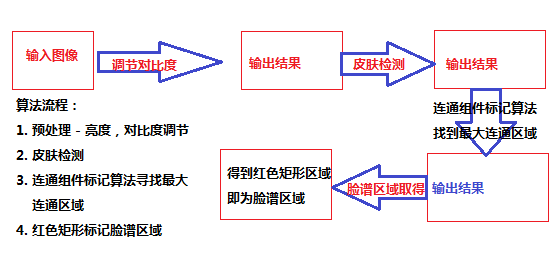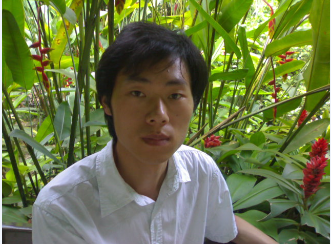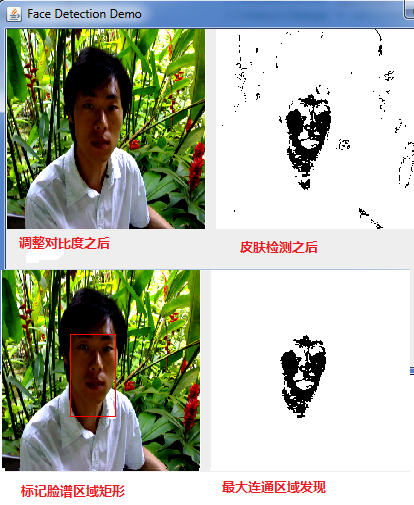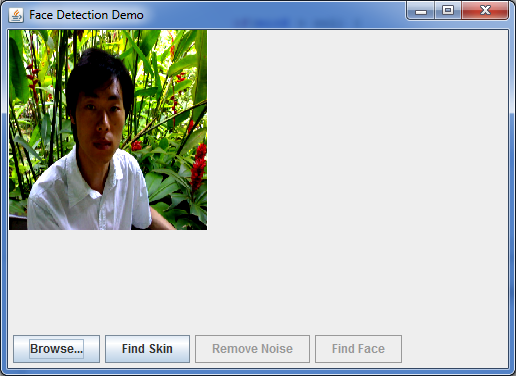图像处理之简单脸谱检测算法
2015-10-20 10:42
435 查看
from: http://blog.csdn.net/jia20003/article/details/7596443
图像处理之简单脸谱检测算法(Simple Face Detection Algorithm)
介绍基于皮肤检测之后的,寻找最大连通区域,完成脸谱检测的算法。大致的算法步骤如下:

原图如下:

每步处理以后的效果:

程序运行,加载选择图像以后的截屏如下:

截屏中显示图片,是适当放缩以后,代码如下:
[java]
view plaincopy
Image scaledImage = rawImg.getScaledInstance(200, 200, Image.SCALE_FAST); // Java Image API, rawImage is source image
g2.drawImage(scaledImage, 0, 0, 200, 200, null);
第一步:图像预处理,预处理的目的是为了减少图像中干扰像素,使得皮肤检测步骤可以得
到更好的效果,最常见的手段是调节对比度与亮度,也可以高斯模糊。关于怎么调节亮度与
对比度可以参见这里:/article/1391105.html
这里调节对比度的算法很简单,源代码如下:
[java]
view plaincopy
package com.gloomyfish.face.detection;
import java.awt.image.BufferedImage;
public class ContrastFilter extends AbstractBufferedImageOp {
private double nContrast = 30;
public ContrastFilter() {
System.out.println("Contrast Filter");
}
@Override
public BufferedImage filter(BufferedImage src, BufferedImage dest) {
int width = src.getWidth();
int height = src.getHeight();
double contrast = (100.0 + nContrast) / 100.0;
contrast *= contrast;
if ( dest == null )
dest = createCompatibleDestImage( src, null );
int[] inPixels = new int[width*height];
int[] outPixels = new int[width*height];
getRGB( src, 0, 0, width, height, inPixels );
int index = 0;
int ta = 0, tr = 0, tg = 0, tb = 0;
for(int row=0; row<height; row++) {
for(int col=0; col<width; col++) {
index = row * width + col;
ta = (inPixels[index] >> 24) & 0xff;
tr = (inPixels[index] >> 16) & 0xff;
tg = (inPixels[index] >> 8) & 0xff;
tb = inPixels[index] & 0xff;
// adjust contrast - red, green, blue
tr = adjustContrast(tr, contrast);
tg = adjustContrast(tg, contrast);
tb = adjustContrast(tb, contrast);
// output RGB pixel
outPixels[index] = (ta << 24) | (tr << 16) | (tg << 8) | tb;
}
}
setRGB( dest, 0, 0, width, height, outPixels );
return dest;
}
public int adjustContrast(int color, double contrast) {
double result = 0;
result = color / 255.0;
result -= 0.5;
result *= contrast;
result += 0.5;
result *=255.0;
return clamp((int)result);
}
public static int clamp(int c) {
if (c < 0)
return 0;
if (c > 255)
return 255;
return c;
}
}
注意:第一步不是必须的,如果图像质量已经很好,可以直接跳过。
第二步:皮肤检测,采用的是基于RGB色彩空间的统计结果来判断一个像素是否为skin像
素,如果是皮肤像素,则设置像素为黑色,否则为白色。给出基于RGB色彩空间的五种皮
肤检测统计方法,最喜欢的一种源代码如下:
[java]
view plaincopy
package com.gloomyfish.face.detection;
import java.awt.image.BufferedImage;
/**
* this skin detection is absolutely good skin classification,
* i love this one very much
*
* this one should be always primary skin detection
* from all five filters
*
* @author zhigang
*
*/
public class SkinFilter4 extends AbstractBufferedImageOp {
@Override
public BufferedImage filter(BufferedImage src, BufferedImage dest) {
int width = src.getWidth();
int height = src.getHeight();
if ( dest == null )
dest = createCompatibleDestImage( src, null );
int[] inPixels = new int[width*height];
int[] outPixels = new int[width*height];
getRGB( src, 0, 0, width, height, inPixels );
int index = 0;
for(int row=0; row<height; row++) {
int ta = 0, tr = 0, tg = 0, tb = 0;
for(int col=0; col<width; col++) {
index = row * width + col;
ta = (inPixels[index] >> 24) & 0xff;
tr = (inPixels[index] >> 16) & 0xff;
tg = (inPixels[index] >> 8) & 0xff;
tb = inPixels[index] & 0xff;
// detect skin method...
double sum = tr + tg + tb;
if (((double)tb/(double)tg<1.249) &&
((double)sum/(double)(3*tr)>0.696) &&
(0.3333-(double)tb/(double)sum>0.014) &&
((double)tg/(double)(3*sum)<0.108))
{
tr = tg = tb = 0;
} else {
tr = tg = tb = 255;
}
outPixels[index] = (ta << 24) | (tr << 16) | (tg << 8) | tb;
}
}
setRGB(dest, 0, 0, width, height, outPixels);
return dest;
}
}
第三步:寻找最大连通区域
使用连通组件标记算法,寻找最大连通区域,关于什么是连通组件标记算法,可以参见这里
/article/1391101.html,里面提到的连通组件算法效率不高,所
以这里我完成了一个更具效率的版本,主要思想是对像素数据进行八邻域寻找连通,然后合
并标记。源代码如下:
[java]
view plaincopy
package com.gloomyfish.face.detection;
import java.util.Arrays;
import java.util.HashMap;
/**
* fast connected component label algorithm
*
* @date 2012-05-23
* @author zhigang
*
*/
public class FastConnectedComponentLabelAlg {
private int bgColor;
private int[] labels;
private int[] outData;
private int dw;
private int dh;
public FastConnectedComponentLabelAlg() {
bgColor = 255; // black color
}
public int[] doLabel(int[] inPixels, int width, int height) {
dw = width;
dh = height;
int nextlabel = 1;
int result = 0;
labels = new int[dw * dh/2];
outData = new int[dw * dh];
for(int i=0; i<labels.length; i++) {
labels[i] = i;
}
// we need to define these two variable arrays.
int[] fourNeighborhoodPixels = new int[8];
int[] fourNeighborhoodLabels = new int[8];
int[] knownLabels = new int[4];
int srcrgb = 0, index = 0;
boolean existedLabel = false;
for(int row = 0; row < height; row ++) {
for(int col = 0; col < width; col++) {
index = row * width + col;
srcrgb = inPixels[index] & 0x000000ff;
if(srcrgb == bgColor) {
result = 0; // which means no labeled for this pixel.
} else {
// we just find the eight neighborhood pixels.
fourNeighborhoodPixels[0] = getPixel(inPixels, row-1, col); // upper cell
fourNeighborhoodPixels[1] = getPixel(inPixels, row, col-1); // left cell
fourNeighborhoodPixels[2] = getPixel(inPixels, row+1, col); // bottom cell
fourNeighborhoodPixels[3] = getPixel(inPixels, row, col+1); // right cell
// four corners pixels
fourNeighborhoodPixels[4] = getPixel(inPixels, row-1, col-1); // upper left corner
fourNeighborhoodPixels[5] = getPixel(inPixels, row-1, col+1); // upper right corner
fourNeighborhoodPixels[6] = getPixel(inPixels, row+1, col-1); // left bottom corner
fourNeighborhoodPixels[7] = getPixel(inPixels, row+1, col+1); // right bottom corner
// get current possible existed labels
fourNeighborhoodLabels[0] = getLabel(outData, row-1, col); // upper cell
fourNeighborhoodLabels[1] = getLabel(outData, row, col-1); // left cell
fourNeighborhoodLabels[2] = getLabel(outData, row+1, col); // bottom cell
fourNeighborhoodLabels[3] = getLabel(outData, row, col+1); // right cell
// four corners labels value
fourNeighborhoodLabels[4] = getLabel(outData, row-1, col-1); // upper left corner
fourNeighborhoodLabels[5] = getLabel(outData, row-1, col+1); // upper right corner
fourNeighborhoodLabels[6] = getLabel(outData, row+1, col-1); // left bottom corner
fourNeighborhoodLabels[7] = getLabel(outData, row+1, col+1); // right bottom corner
knownLabels[0] = fourNeighborhoodLabels[0];
knownLabels[1] = fourNeighborhoodLabels[1];
knownLabels[2] = fourNeighborhoodLabels[4];
knownLabels[3] = fourNeighborhoodLabels[5];
existedLabel = false;
for(int k=0; k<fourNeighborhoodLabels.length; k++) {
if(fourNeighborhoodLabels[k] != 0) {
existedLabel = true;
break;
}
}
if(!existedLabel) {
result = nextlabel;
nextlabel++;
} else {
int found = -1, count = 0;
for(int i=0; i<fourNeighborhoodPixels.length; i++) {
if(fourNeighborhoodPixels[i] != bgColor) {
found = i;
count++;
}
}
if(count == 1) {
result = (fourNeighborhoodLabels[found] == 0) ? nextlabel : fourNeighborhoodLabels[found];
} else {
result = (fourNeighborhoodLabels[found] == 0) ? nextlabel : fourNeighborhoodLabels[found];
for(int j=0; j<knownLabels.length; j++) {
if(knownLabels[j] != 0 && knownLabels[j] != result &&
knownLabels[j] < result) {
result = knownLabels[j];
}
}
boolean needMerge = false;
for(int mm = 0; mm < knownLabels.length; mm++ ) {
if(knownLabels[0] != knownLabels[mm] && knownLabels[mm] != 0) {
needMerge = true;
}
}
// merge the labels now....
if(needMerge) {
int minLabel = knownLabels[0];
for(int m=0; m<knownLabels.length; m++) {
if(minLabel > knownLabels[m] && knownLabels[m] != 0) {
minLabel = knownLabels[m];
}
}
// find the final label number...
result = (minLabel == 0) ? result : minLabel;
// re-assign the label number now...
if(knownLabels[0] != 0) {
setData(outData, row-1, col, result);
}
if(knownLabels[1] != 0) {
setData(outData, row, col-1, result);
}
if(knownLabels[2] != 0) {
setData(outData, row-1, col-1, result);
}
if(knownLabels[3] != 0) {
setData(outData, row-1, col+1, result);
}
}
}
}
}
outData[index] = result; // assign to label
}
}
// post merge each labels now
for(int row = 0; row < height; row ++) {
for(int col = 0; col < width; col++) {
index = row * width + col;
mergeLabels(index);
}
}
// labels statistic
HashMap<Integer, Integer> labelMap = new HashMap<Integer, Integer>();
for(int d=0; d<outData.length; d++) {
if(outData[d] != 0) {
if(labelMap.containsKey(outData[d])) {
Integer count = labelMap.get(outData[d]);
count+=1;
labelMap.put(outData[d], count);
} else {
labelMap.put(outData[d], 1);
}
}
}
// try to find the max connected component
Integer[] keys = labelMap.keySet().toArray(new Integer[0]);
Arrays.sort(keys);
int maxKey = 1;
int max = 0;
for(Integer key : keys) {
if(max < labelMap.get(key)){
max = labelMap.get(key);
maxKey = key;
}
System.out.println( "Number of " + key + " = " + labelMap.get(key));
}
System.out.println("maxkey = " + maxKey);
System.out.println("max connected component number = " + max);
return outData;
}
private void mergeLabels(int index) {
int row = index / dw;
int col = index % dw;
// get current possible existed labels
int min = getLabel(outData, row, col);
if(min == 0) return;
if(min > getLabel(outData, row-1, col) && getLabel(outData, row-1, col) != 0) {
min = getLabel(outData, row-1, col);
}
if(min > getLabel(outData, row, col-1) && getLabel(outData, row, col-1) != 0) {
min = getLabel(outData, row, col-1);
}
if(min > getLabel(outData, row+1, col) && getLabel(outData, row+1, col) != 0) {
min = getLabel(outData, row+1, col);
}
if(min > getLabel(outData, row, col+1) && getLabel(outData, row, col+1) != 0) {
min = getLabel(outData, row, col+1);
}
if(min > getLabel(outData, row-1, col-1) && getLabel(outData, row-1, col-1) != 0) {
min = getLabel(outData, row-1, col-1);
}
if(min > getLabel(outData, row-1, col+1) && getLabel(outData, row-1, col+1) != 0) {
min = getLabel(outData, row-1, col+1);
}
if(min > getLabel(outData, row+1, col-1) && getLabel(outData, row+1, col-1) != 0) {
min = getLabel(outData, row+1, col-1);
}
if(min > getLabel(outData, row+1, col+1) && getLabel(outData, row+1, col+1) != 0) {
min = getLabel(outData, row+1, col+1);
}
if(getLabel(outData, row, col) == min)
return;
outData[index] = min;
// eight neighborhood pixels
if((row -1) >= 0) {
mergeLabels((row-1)*dw + col);
}
if((col-1) >= 0) {
mergeLabels(row*dw+col-1);
}
if((row+1) < dh) {
mergeLabels((row + 1)*dw+col);
}
if((col+1) < dw) {
mergeLabels((row)*dw+col+1);
}
if((row-1)>= 0 && (col-1) >=0) {
mergeLabels((row-1)*dw+col-1);
}
if((row-1)>= 0 && (col+1) < dw) {
mergeLabels((row-1)*dw+col+1);
}
if((row+1) < dh && (col-1) >=0) {
mergeLabels((row+1)*dw+col-1);
}
if((row+1) < dh && (col+1) < dw) {
mergeLabels((row+1)*dw+col+1);
}
}
private void setData(int[] data, int row, int col, int value) {
if(row < 0 || row >= dh) {
return;
}
if(col < 0 || col >= dw) {
return;
}
int index = row * dw + col;
data[index] = value;
}
private int getLabel(int[] data, int row, int col) {
// handle the edge pixels
if(row < 0 || row >= dh) {
return 0;
}
if(col < 0 || col >= dw) {
return 0;
}
int index = row * dw + col;
return (data[index] & 0x000000ff);
}
private int getPixel(int[] data, int row, int col) {
// handle the edge pixels
if(row < 0 || row >= dh) {
return bgColor;
}
if(col < 0 || col >= dw) {
return bgColor;
}
int index = row * dw + col;
return (data[index] & 0x000000ff);
}
/**
* binary image data:
*
* 255, 0, 0, 255, 0, 255, 255, 0, 255, 255, 255,
* 255, 0, 0, 255, 0, 255, 255, 0, 0, 255, 0,
* 255, 0, 0, 0, 255, 255, 255, 255, 255, 0, 0,
* 255, 255, 0, 255, 255, 255, 0, 255, 0, 0, 255
* 255, 255, 0, 0, 0, 0, 255, 0, 0, 0, 0
*
* height = 5, width = 11
* @param args
*/
public static int[] imageData = new int[]{
255, 0, 0, 255, 0, 255, 255, 0, 255, 255, 255,
255, 0, 0, 255, 0, 255, 255, 0, 0, 255, 0,
255, 0, 0, 0, 255, 255, 255, 255, 255, 0, 0,
255, 255, 0, 255, 255, 255, 0, 255, 0, 0, 255,
255, 255, 0, 0, 0, 0, 255, 0, 0, 0, 0
};
public static void main(String[] args) {
FastConnectedComponentLabelAlg ccl = new FastConnectedComponentLabelAlg();
int[] outData = ccl.doLabel(imageData, 11, 5);
for(int i=0; i<5; i++) {
System.out.println("--------------------");
for(int j = 0; j<11; j++) {
int index = i * 11 + j;
if(j != 0) {
System.out.print(",");
}
System.out.print(outData[index]);
}
System.out.println();
}
}
}
找到最大连通区域以后,对最大连通区域数据进行扫描,找出最小点,即矩形区域左上角坐
标,找出最大点,即矩形区域右下角坐标。知道这四个点坐标以后,在原图上打上红色矩形
框,标记出脸谱位置。寻找四个点坐标的实现代码如下:
[java]
view plaincopy
private void getFaceRectangel() {
int width = resultImage.getWidth();
int height = resultImage.getHeight();
int[] inPixels = new int[width*height];
getRGB(resultImage, 0, 0, width, height, inPixels);
int index = 0;
int ta = 0, tr = 0, tg = 0, tb = 0;
for(int row=0; row<height; row++) {
for(int col=0; col<width; col++) {
index = row * width + col;
ta = (inPixels[index] >> 24) & 0xff;
tr = (inPixels[index] >> 16) & 0xff;
tg = (inPixels[index] >> 8) & 0xff;
tb = inPixels[index] & 0xff;
if(tr == tg && tg == tb && tb == 0) { // face skin
if(minY > row) {
minY = row;
}
if(minX > col) {
minX = col;
}
if(maxY < row) {
maxY = row;
}
if(maxX < col) {
maxX = col;
}
}
}
}
}
缺点:
此算法不支持多脸谱检测,不支持裸体中的脸谱检测,但是根据人脸的
生物学特征可以进一步细化分析,支持裸体人脸检测。
写本文章的目的:本例为图像处理综合运行的一个简单实例。同时人脸检
测也是个感兴趣的话题。
图像处理之简单脸谱检测算法(Simple Face Detection Algorithm)
介绍基于皮肤检测之后的,寻找最大连通区域,完成脸谱检测的算法。大致的算法步骤如下:

原图如下:

每步处理以后的效果:

程序运行,加载选择图像以后的截屏如下:

截屏中显示图片,是适当放缩以后,代码如下:
[java]
view plaincopy
Image scaledImage = rawImg.getScaledInstance(200, 200, Image.SCALE_FAST); // Java Image API, rawImage is source image
g2.drawImage(scaledImage, 0, 0, 200, 200, null);
第一步:图像预处理,预处理的目的是为了减少图像中干扰像素,使得皮肤检测步骤可以得
到更好的效果,最常见的手段是调节对比度与亮度,也可以高斯模糊。关于怎么调节亮度与
对比度可以参见这里:/article/1391105.html
这里调节对比度的算法很简单,源代码如下:
[java]
view plaincopy
package com.gloomyfish.face.detection;
import java.awt.image.BufferedImage;
public class ContrastFilter extends AbstractBufferedImageOp {
private double nContrast = 30;
public ContrastFilter() {
System.out.println("Contrast Filter");
}
@Override
public BufferedImage filter(BufferedImage src, BufferedImage dest) {
int width = src.getWidth();
int height = src.getHeight();
double contrast = (100.0 + nContrast) / 100.0;
contrast *= contrast;
if ( dest == null )
dest = createCompatibleDestImage( src, null );
int[] inPixels = new int[width*height];
int[] outPixels = new int[width*height];
getRGB( src, 0, 0, width, height, inPixels );
int index = 0;
int ta = 0, tr = 0, tg = 0, tb = 0;
for(int row=0; row<height; row++) {
for(int col=0; col<width; col++) {
index = row * width + col;
ta = (inPixels[index] >> 24) & 0xff;
tr = (inPixels[index] >> 16) & 0xff;
tg = (inPixels[index] >> 8) & 0xff;
tb = inPixels[index] & 0xff;
// adjust contrast - red, green, blue
tr = adjustContrast(tr, contrast);
tg = adjustContrast(tg, contrast);
tb = adjustContrast(tb, contrast);
// output RGB pixel
outPixels[index] = (ta << 24) | (tr << 16) | (tg << 8) | tb;
}
}
setRGB( dest, 0, 0, width, height, outPixels );
return dest;
}
public int adjustContrast(int color, double contrast) {
double result = 0;
result = color / 255.0;
result -= 0.5;
result *= contrast;
result += 0.5;
result *=255.0;
return clamp((int)result);
}
public static int clamp(int c) {
if (c < 0)
return 0;
if (c > 255)
return 255;
return c;
}
}
注意:第一步不是必须的,如果图像质量已经很好,可以直接跳过。
第二步:皮肤检测,采用的是基于RGB色彩空间的统计结果来判断一个像素是否为skin像
素,如果是皮肤像素,则设置像素为黑色,否则为白色。给出基于RGB色彩空间的五种皮
肤检测统计方法,最喜欢的一种源代码如下:
[java]
view plaincopy
package com.gloomyfish.face.detection;
import java.awt.image.BufferedImage;
/**
* this skin detection is absolutely good skin classification,
* i love this one very much
*
* this one should be always primary skin detection
* from all five filters
*
* @author zhigang
*
*/
public class SkinFilter4 extends AbstractBufferedImageOp {
@Override
public BufferedImage filter(BufferedImage src, BufferedImage dest) {
int width = src.getWidth();
int height = src.getHeight();
if ( dest == null )
dest = createCompatibleDestImage( src, null );
int[] inPixels = new int[width*height];
int[] outPixels = new int[width*height];
getRGB( src, 0, 0, width, height, inPixels );
int index = 0;
for(int row=0; row<height; row++) {
int ta = 0, tr = 0, tg = 0, tb = 0;
for(int col=0; col<width; col++) {
index = row * width + col;
ta = (inPixels[index] >> 24) & 0xff;
tr = (inPixels[index] >> 16) & 0xff;
tg = (inPixels[index] >> 8) & 0xff;
tb = inPixels[index] & 0xff;
// detect skin method...
double sum = tr + tg + tb;
if (((double)tb/(double)tg<1.249) &&
((double)sum/(double)(3*tr)>0.696) &&
(0.3333-(double)tb/(double)sum>0.014) &&
((double)tg/(double)(3*sum)<0.108))
{
tr = tg = tb = 0;
} else {
tr = tg = tb = 255;
}
outPixels[index] = (ta << 24) | (tr << 16) | (tg << 8) | tb;
}
}
setRGB(dest, 0, 0, width, height, outPixels);
return dest;
}
}
第三步:寻找最大连通区域
使用连通组件标记算法,寻找最大连通区域,关于什么是连通组件标记算法,可以参见这里
/article/1391101.html,里面提到的连通组件算法效率不高,所
以这里我完成了一个更具效率的版本,主要思想是对像素数据进行八邻域寻找连通,然后合
并标记。源代码如下:
[java]
view plaincopy
package com.gloomyfish.face.detection;
import java.util.Arrays;
import java.util.HashMap;
/**
* fast connected component label algorithm
*
* @date 2012-05-23
* @author zhigang
*
*/
public class FastConnectedComponentLabelAlg {
private int bgColor;
private int[] labels;
private int[] outData;
private int dw;
private int dh;
public FastConnectedComponentLabelAlg() {
bgColor = 255; // black color
}
public int[] doLabel(int[] inPixels, int width, int height) {
dw = width;
dh = height;
int nextlabel = 1;
int result = 0;
labels = new int[dw * dh/2];
outData = new int[dw * dh];
for(int i=0; i<labels.length; i++) {
labels[i] = i;
}
// we need to define these two variable arrays.
int[] fourNeighborhoodPixels = new int[8];
int[] fourNeighborhoodLabels = new int[8];
int[] knownLabels = new int[4];
int srcrgb = 0, index = 0;
boolean existedLabel = false;
for(int row = 0; row < height; row ++) {
for(int col = 0; col < width; col++) {
index = row * width + col;
srcrgb = inPixels[index] & 0x000000ff;
if(srcrgb == bgColor) {
result = 0; // which means no labeled for this pixel.
} else {
// we just find the eight neighborhood pixels.
fourNeighborhoodPixels[0] = getPixel(inPixels, row-1, col); // upper cell
fourNeighborhoodPixels[1] = getPixel(inPixels, row, col-1); // left cell
fourNeighborhoodPixels[2] = getPixel(inPixels, row+1, col); // bottom cell
fourNeighborhoodPixels[3] = getPixel(inPixels, row, col+1); // right cell
// four corners pixels
fourNeighborhoodPixels[4] = getPixel(inPixels, row-1, col-1); // upper left corner
fourNeighborhoodPixels[5] = getPixel(inPixels, row-1, col+1); // upper right corner
fourNeighborhoodPixels[6] = getPixel(inPixels, row+1, col-1); // left bottom corner
fourNeighborhoodPixels[7] = getPixel(inPixels, row+1, col+1); // right bottom corner
// get current possible existed labels
fourNeighborhoodLabels[0] = getLabel(outData, row-1, col); // upper cell
fourNeighborhoodLabels[1] = getLabel(outData, row, col-1); // left cell
fourNeighborhoodLabels[2] = getLabel(outData, row+1, col); // bottom cell
fourNeighborhoodLabels[3] = getLabel(outData, row, col+1); // right cell
// four corners labels value
fourNeighborhoodLabels[4] = getLabel(outData, row-1, col-1); // upper left corner
fourNeighborhoodLabels[5] = getLabel(outData, row-1, col+1); // upper right corner
fourNeighborhoodLabels[6] = getLabel(outData, row+1, col-1); // left bottom corner
fourNeighborhoodLabels[7] = getLabel(outData, row+1, col+1); // right bottom corner
knownLabels[0] = fourNeighborhoodLabels[0];
knownLabels[1] = fourNeighborhoodLabels[1];
knownLabels[2] = fourNeighborhoodLabels[4];
knownLabels[3] = fourNeighborhoodLabels[5];
existedLabel = false;
for(int k=0; k<fourNeighborhoodLabels.length; k++) {
if(fourNeighborhoodLabels[k] != 0) {
existedLabel = true;
break;
}
}
if(!existedLabel) {
result = nextlabel;
nextlabel++;
} else {
int found = -1, count = 0;
for(int i=0; i<fourNeighborhoodPixels.length; i++) {
if(fourNeighborhoodPixels[i] != bgColor) {
found = i;
count++;
}
}
if(count == 1) {
result = (fourNeighborhoodLabels[found] == 0) ? nextlabel : fourNeighborhoodLabels[found];
} else {
result = (fourNeighborhoodLabels[found] == 0) ? nextlabel : fourNeighborhoodLabels[found];
for(int j=0; j<knownLabels.length; j++) {
if(knownLabels[j] != 0 && knownLabels[j] != result &&
knownLabels[j] < result) {
result = knownLabels[j];
}
}
boolean needMerge = false;
for(int mm = 0; mm < knownLabels.length; mm++ ) {
if(knownLabels[0] != knownLabels[mm] && knownLabels[mm] != 0) {
needMerge = true;
}
}
// merge the labels now....
if(needMerge) {
int minLabel = knownLabels[0];
for(int m=0; m<knownLabels.length; m++) {
if(minLabel > knownLabels[m] && knownLabels[m] != 0) {
minLabel = knownLabels[m];
}
}
// find the final label number...
result = (minLabel == 0) ? result : minLabel;
// re-assign the label number now...
if(knownLabels[0] != 0) {
setData(outData, row-1, col, result);
}
if(knownLabels[1] != 0) {
setData(outData, row, col-1, result);
}
if(knownLabels[2] != 0) {
setData(outData, row-1, col-1, result);
}
if(knownLabels[3] != 0) {
setData(outData, row-1, col+1, result);
}
}
}
}
}
outData[index] = result; // assign to label
}
}
// post merge each labels now
for(int row = 0; row < height; row ++) {
for(int col = 0; col < width; col++) {
index = row * width + col;
mergeLabels(index);
}
}
// labels statistic
HashMap<Integer, Integer> labelMap = new HashMap<Integer, Integer>();
for(int d=0; d<outData.length; d++) {
if(outData[d] != 0) {
if(labelMap.containsKey(outData[d])) {
Integer count = labelMap.get(outData[d]);
count+=1;
labelMap.put(outData[d], count);
} else {
labelMap.put(outData[d], 1);
}
}
}
// try to find the max connected component
Integer[] keys = labelMap.keySet().toArray(new Integer[0]);
Arrays.sort(keys);
int maxKey = 1;
int max = 0;
for(Integer key : keys) {
if(max < labelMap.get(key)){
max = labelMap.get(key);
maxKey = key;
}
System.out.println( "Number of " + key + " = " + labelMap.get(key));
}
System.out.println("maxkey = " + maxKey);
System.out.println("max connected component number = " + max);
return outData;
}
private void mergeLabels(int index) {
int row = index / dw;
int col = index % dw;
// get current possible existed labels
int min = getLabel(outData, row, col);
if(min == 0) return;
if(min > getLabel(outData, row-1, col) && getLabel(outData, row-1, col) != 0) {
min = getLabel(outData, row-1, col);
}
if(min > getLabel(outData, row, col-1) && getLabel(outData, row, col-1) != 0) {
min = getLabel(outData, row, col-1);
}
if(min > getLabel(outData, row+1, col) && getLabel(outData, row+1, col) != 0) {
min = getLabel(outData, row+1, col);
}
if(min > getLabel(outData, row, col+1) && getLabel(outData, row, col+1) != 0) {
min = getLabel(outData, row, col+1);
}
if(min > getLabel(outData, row-1, col-1) && getLabel(outData, row-1, col-1) != 0) {
min = getLabel(outData, row-1, col-1);
}
if(min > getLabel(outData, row-1, col+1) && getLabel(outData, row-1, col+1) != 0) {
min = getLabel(outData, row-1, col+1);
}
if(min > getLabel(outData, row+1, col-1) && getLabel(outData, row+1, col-1) != 0) {
min = getLabel(outData, row+1, col-1);
}
if(min > getLabel(outData, row+1, col+1) && getLabel(outData, row+1, col+1) != 0) {
min = getLabel(outData, row+1, col+1);
}
if(getLabel(outData, row, col) == min)
return;
outData[index] = min;
// eight neighborhood pixels
if((row -1) >= 0) {
mergeLabels((row-1)*dw + col);
}
if((col-1) >= 0) {
mergeLabels(row*dw+col-1);
}
if((row+1) < dh) {
mergeLabels((row + 1)*dw+col);
}
if((col+1) < dw) {
mergeLabels((row)*dw+col+1);
}
if((row-1)>= 0 && (col-1) >=0) {
mergeLabels((row-1)*dw+col-1);
}
if((row-1)>= 0 && (col+1) < dw) {
mergeLabels((row-1)*dw+col+1);
}
if((row+1) < dh && (col-1) >=0) {
mergeLabels((row+1)*dw+col-1);
}
if((row+1) < dh && (col+1) < dw) {
mergeLabels((row+1)*dw+col+1);
}
}
private void setData(int[] data, int row, int col, int value) {
if(row < 0 || row >= dh) {
return;
}
if(col < 0 || col >= dw) {
return;
}
int index = row * dw + col;
data[index] = value;
}
private int getLabel(int[] data, int row, int col) {
// handle the edge pixels
if(row < 0 || row >= dh) {
return 0;
}
if(col < 0 || col >= dw) {
return 0;
}
int index = row * dw + col;
return (data[index] & 0x000000ff);
}
private int getPixel(int[] data, int row, int col) {
// handle the edge pixels
if(row < 0 || row >= dh) {
return bgColor;
}
if(col < 0 || col >= dw) {
return bgColor;
}
int index = row * dw + col;
return (data[index] & 0x000000ff);
}
/**
* binary image data:
*
* 255, 0, 0, 255, 0, 255, 255, 0, 255, 255, 255,
* 255, 0, 0, 255, 0, 255, 255, 0, 0, 255, 0,
* 255, 0, 0, 0, 255, 255, 255, 255, 255, 0, 0,
* 255, 255, 0, 255, 255, 255, 0, 255, 0, 0, 255
* 255, 255, 0, 0, 0, 0, 255, 0, 0, 0, 0
*
* height = 5, width = 11
* @param args
*/
public static int[] imageData = new int[]{
255, 0, 0, 255, 0, 255, 255, 0, 255, 255, 255,
255, 0, 0, 255, 0, 255, 255, 0, 0, 255, 0,
255, 0, 0, 0, 255, 255, 255, 255, 255, 0, 0,
255, 255, 0, 255, 255, 255, 0, 255, 0, 0, 255,
255, 255, 0, 0, 0, 0, 255, 0, 0, 0, 0
};
public static void main(String[] args) {
FastConnectedComponentLabelAlg ccl = new FastConnectedComponentLabelAlg();
int[] outData = ccl.doLabel(imageData, 11, 5);
for(int i=0; i<5; i++) {
System.out.println("--------------------");
for(int j = 0; j<11; j++) {
int index = i * 11 + j;
if(j != 0) {
System.out.print(",");
}
System.out.print(outData[index]);
}
System.out.println();
}
}
}
找到最大连通区域以后,对最大连通区域数据进行扫描,找出最小点,即矩形区域左上角坐
标,找出最大点,即矩形区域右下角坐标。知道这四个点坐标以后,在原图上打上红色矩形
框,标记出脸谱位置。寻找四个点坐标的实现代码如下:
[java]
view plaincopy
private void getFaceRectangel() {
int width = resultImage.getWidth();
int height = resultImage.getHeight();
int[] inPixels = new int[width*height];
getRGB(resultImage, 0, 0, width, height, inPixels);
int index = 0;
int ta = 0, tr = 0, tg = 0, tb = 0;
for(int row=0; row<height; row++) {
for(int col=0; col<width; col++) {
index = row * width + col;
ta = (inPixels[index] >> 24) & 0xff;
tr = (inPixels[index] >> 16) & 0xff;
tg = (inPixels[index] >> 8) & 0xff;
tb = inPixels[index] & 0xff;
if(tr == tg && tg == tb && tb == 0) { // face skin
if(minY > row) {
minY = row;
}
if(minX > col) {
minX = col;
}
if(maxY < row) {
maxY = row;
}
if(maxX < col) {
maxX = col;
}
}
}
}
}
缺点:
此算法不支持多脸谱检测,不支持裸体中的脸谱检测,但是根据人脸的
生物学特征可以进一步细化分析,支持裸体人脸检测。
写本文章的目的:本例为图像处理综合运行的一个简单实例。同时人脸检
测也是个感兴趣的话题。
相关文章推荐
- HTML5移动开发中的meta与link
- ThinkPHP3.2 volist嵌套循环显示原理
- 一封电气人的情书,理工男竟能写的如此文艺... (hope you understand what I mean)
- 导入classes.jar到项目
- 导出product 产品,启动时会出现cmd界面
- 在String.xml文件中添加特殊字符
- 史上最全的iOS面试题及答案,且看且珍藏,错过就没有喽!
- HDU 5505 GT and numbers(gcd)
- 在一个Hybrid Cloud上部署测试的SharePoint farm
- testng(二) 美化报告,jenkins集成
- centOS安装scipy
- Oracle 组件 系列 小结
- FragmentTransaction管理 Activity中 fragment的替换
- msleep问题
- 算法题 子数组之和为零
- 最全的常用正则表达式大全——包括校验数字、字符、一些特殊的需求等等
- POJ 1611 The Suspects
- Please ensure that adb is correctly located at……问题解决方案
- 移动web设计稿尺寸,关于移动web尺寸的那点事
- HDU 5505 GT and numbers(gcd)
